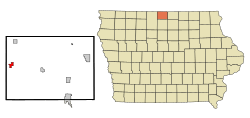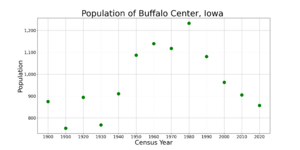Buffalo Center, Iowa facts for kids
Quick facts for kids
Buffalo Center, Iowa
|
|
|---|---|

Location of Buffalo Center, Iowa
|
|
| Country | |
| State | |
| County | Winnebago |
| Area | |
| • Total | 1.07 sq mi (2.77 km2) |
| • Land | 1.07 sq mi (2.77 km2) |
| • Water | 0.00 sq mi (0.00 km2) |
| Elevation | 1,191 ft (363 m) |
| Population
(2020)
|
|
| • Total | 857 |
| • Density | 800.19/sq mi (308.98/km2) |
| Time zone | UTC-6 (Central (CST)) |
| • Summer (DST) | UTC-5 (CDT) |
| ZIP code |
50424
|
| Area code(s) | 641 |
| FIPS code | 19-09280 |
| GNIS feature ID | 0454952 |
Buffalo Center is a small city in Winnebago County, Iowa, United States. It's home to about 857 people, according to the 2020 census. The city's ZIP code is 50424.
Contents
History of Buffalo Center
Buffalo Center was officially created in 1892. It became a city later that same year. In 1996, it became the main community for the new North Iowa Community School.
How Buffalo Center Got Its Name
The town is located about seven miles south of the Minnesota border. It was named Buffalo Center because it sits right in the middle of the north and south parts of Buffalo Creek. The town wasn't always in its current spot. It first started south of where it is now. It moved north when the Chicago and Iowa Western Railroad built new train lines in northern Iowa.
Early Days and Challenges
Buffalo Center was settled in 1892 on land that was quite swampy. This land later had to be drained and tiled to make it suitable for building. One of the first settlers, Howard Pomeroy, used a mower to cut paths through his wheat fields. These paths showed where the new streets would be. A hardware store and a blacksmith shop were the very first businesses to open in the town.
Buffalo Center has faced many challenges over the years. Main Street businesses have been damaged by fires several times. The town has also seen occasional tornadoes and severe winter storms. One famous storm was the Armistice Day blizzard on November 11, 1940. It was a very tough storm for the region.
A Pioneer in Education
On August 23, 1897, Buffalo Center made history. It became the first school system west of the Mississippi River to combine smaller schools into one. This is called a "consolidated" school system. It's believed to be the second one in the entire country!
Buffalo Center Today
Today, Buffalo Center is a lively town. It has a modern community center and its first museum. There are also several new businesses. The town has a K-12 consolidated school. This school teaches students from Buffalo Center and nearby towns like Rake, Lakota, and Thompson.
Buffalo Center is known for its fun community events. The Fourth of July celebration is a big, all-day event. It includes a 5K race, a parade, music, games for kids, and a huge fireworks show. Other yearly events include the Winter Gala, Crazy Days, and an Old-Fashioned Christmas Celebration. In 2022, the town started a new event called 'Bison Days' in late July. This celebration also features fireworks, a parade, games, free food, and a concert.
The city also has a volunteer fire department and a volunteer ambulance service. These dedicated volunteers help keep the community safe.
Geography of Buffalo Center
Buffalo Center is located at 43°23′11″N 93°56′54″W / 43.38639°N 93.94833°W.
Land Area
The city covers a total area of about 1.07 square miles (2.77 square kilometers). All of this area is land, with no significant bodies of water within the city limits.
Population and People
| Historical populations | ||
|---|---|---|
| Year | Pop. | ±% |
| 1900 | 875 | — |
| 1910 | 753 | −13.9% |
| 1920 | 894 | +18.7% |
| 1930 | 768 | −14.1% |
| 1940 | 911 | +18.6% |
| 1950 | 1,087 | +19.3% |
| 1960 | 1,140 | +4.9% |
| 1970 | 1,118 | −1.9% |
| 1980 | 1,233 | +10.3% |
| 1990 | 1,081 | −12.3% |
| 2000 | 963 | −10.9% |
| 2010 | 905 | −6.0% |
| 2020 | 857 | −5.3% |
| Source: and Iowa Data Center Source: |
||
2020 Census Overview
In 2020, Buffalo Center had 857 people living in 359 households. The city had about 800 people per square mile. Most residents were White (92.5%). About 6.2% of the population identified as Hispanic or Latino.
The average age in the city was 47.7 years old. About 22.3% of the residents were under 20 years old. Also, 30.2% were 65 years or older. The population was slightly more female (52.7%) than male (47.3%).
2010 Census Overview
In 2010, there were 905 people living in Buffalo Center. There were 405 households in total. The population density was about 846 people per square mile. Most residents were White (96.1%). About 6.0% of the population was Hispanic or Latino.
The median age was 48.3 years. About 23.1% of residents were under 18 years old. Also, 30.2% were 65 years or older. The population was 46.6% male and 53.4% female.
Education in Buffalo Center
Buffalo Center is part of the North Iowa Community School District. This district was formed on July 1, 1996. It combined the Buffalo Center–Rake–Lakota Community School District and the Thompson Community School District.
North Iowa Community School
Buffalo Center is home to North Iowa Community School, which is a high school. This school was the first "consolidated" school west of the Mississippi River. A consolidated school means it brings together students from several smaller areas.
Students at North Iowa Community School come from Buffalo Center. They also come from the nearby communities of Lakota, Rake, and Thompson. The school's mascot is the Bison. This mascot has been a symbol for Buffalo Center for many years.
In March 2024, the North Iowa Community School District decided to switch to a four-day school week. This change was suggested by Superintendent Joe Erickson.
School Sports and Conferences
The Bison sports teams have a long history. They were part of the North Iowa Conference since it started in 1929. Other local schools like Rake, Lakota, and Thompson were part of the State Line Conference.
In 2015, North Iowa High School became one of the first nine schools to join the Top of Iowa Conference - West. This new conference provides a place for schools to compete in various sports.
See also
 In Spanish: Buffalo Center (Iowa) para niños
In Spanish: Buffalo Center (Iowa) para niños


